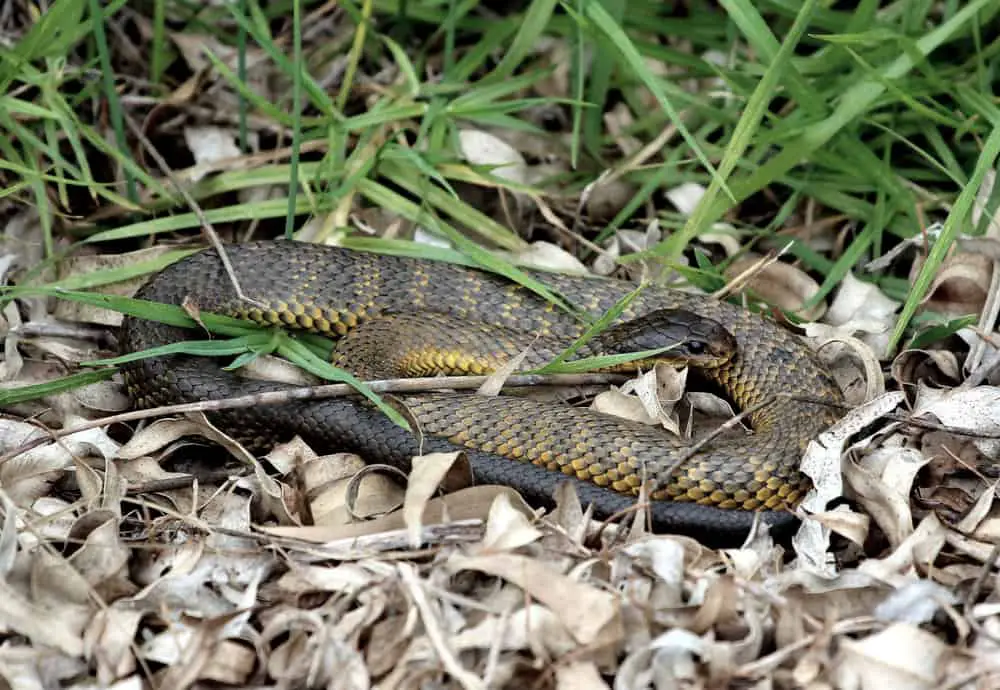Tiger snakes (Notechis scutatus) are a species of venomous snake native to Australia. They belong to the Elapidae family, which includes other well-known Australian snakes such as cobras and sea snakes. These highly adaptable reptiles have become widespread throughout much of Australia’s coastal regions, where they can be found in nearly all habitats ranging from grasslands and woodlands to wetlands and rainforests.
Tiger Snakes vary widely in size depending on their habitat, but generally reach lengths between 1 meter (3 feet) up to 2 meters (6 feet). Their distinctive coloration consists of an olive green base with yellowish crossbands running along the length of its body. The banding patterns serve as a defense mechanism against predators by camouflaging them among dense vegetation or rocky outcrops.
The behavior of tiger snakes is largely dependent on temperature; during cooler months when temperatures drop below 20 degrees Celsius (68 Fahrenheit), these animals become sluggish and less active. In warmer conditions however, tiger snakes will hunt for prey such as frogs, rodents and small birds–making them both efficient predators and an important top predator within Australia’s ecosystems.

Species Overview
Tiger snakes are a species of venomous snake native to Australia. They are part of the Elapidae family, which includes many other species of venomous reptiles and can be found in different habitats throughout the country.
These medium-sized snakes typically grow to around 1 meter in length and have distinctive yellow or olive stripes running along their back. Tiger snakes possess highly potent neurotoxic venom that is capable of causing paralysis, respiratory failure, and death if not treated quickly enough with antivenom.
The diet of tiger snakes consists mainly of rodents, frogs, lizards, and even small birds on occasion. When hunting for prey, these nocturnal predators will often use ambush tactics from within dense vegetation so as to gain the element of surprise over unsuspecting victims before delivering a fatal bite. In addition, tiger snakes also rely heavily on water sources such as streams and lakes for hydration purposes when living in drier regions where regular rainfall may be scarce.
Despite being one of the more dangerous species among Australian reptiles, tiger snakes do play an important role in maintaining healthy biodiversity levels by keeping rodent populations under control while also providing food sources for larger predators like owls and eagles.
As such, it is important that we protect these creatures despite their potentially harmful nature towards humans because they too have a place in our ecosystems just like any other creature does.
Physical Characteristics
The tiger snake is a species of venomous snake from the Elapidae family. It is known for its distinctive scalation pattern, which consists of dark crossbands on a light background and can be found in various color variations.
The body length of the adult tiger snake ranges anywhere between 0.7-1 meter long with some individuals reaching lengths up to 1.5 meters. Their eye markings are typically triangular shaped or two vertical bars extending outwards from their eyes.
In terms of venom toxicity, it has been classified as one of Australia’s most dangerous snakes due to its highly toxic neurotoxin compounds that affect the nervous system and cause respiratory failure if left untreated. They also produce myotoxins which affects muscle tissue leading to paralysis or death within minutes after being bitten by this species.
Due to their distinct physical characteristics, they have adapted over time to different environmental conditions such as rocky terrain, grassland areas, and even agricultural farms where food sources are plentiful making them an opportunistic feeder when hunting for prey.
This adaptation enables them to inhabit more diverse habitats compared to other Australian elapids like the red-bellied black snake or dugite which remain mostly confined to coastal regions throughout Western Australia and South Australia respectively.
Overall, these adaptations make the tiger snake well suited for life in many environments across Australia providing it with enough resources for both feeding and sheltering purposes while also avoiding potential predators in densely populated areas.
Natural Habitat
Tiger snakes are found in a variety of habitats, including forest, grassland, coastal areas, deserts and mountains. In forests they tend to be found near water sources such as streams or rivers where there is ample cover provided by dense vegetation. Here they feed on frogs and other small reptiles.
Grasslands provide more open spaces for tiger snakes to hunt their prey. They often bask in the sun during the day before hunting at night when temperatures cool down. Coastal regions offer plenty of food sources such as fish and crabs which can make up a large part of the snake’s diet. Tiger snakes may also venture into salt marshes in search of food.
Deserts present special challenges for tiger snakes due to extreme temperatures and low humidity levels. The species must adapt behavioral patterns to survive in this environment; spending much of the day underground until evening hours when it becomes cooler above ground. Mountain ranges provide an array of microhabitats that allow tiger snakes to access different types of food sources depending on altitude level and seasonality.
In summary, tiger snakes inhabit multiple habitat types across Australia, adapting their behavior according to temperature extremes while exploiting various food opportunities throughout each region.
Behavior And Diet
The behavioral patterns of tiger snakes vary significantly depending on their geographic location. In terms of hunting behavior, they tend to utilize ambush tactics and wait patiently until the prey is within striking range before pouncing swiftly with a powerful strike.
Prey selection varies greatly among individuals; however, most commonly small mammals, birds, frogs and lizards are consumed. The diet composition may also differ based on seasonality or availability of resources in certain areas.
Generally speaking, dietary preferences consist mainly of vertebrates such as mice and rats but can include invertebrates like insects when other food sources become scarce. Tiger snakes will occasionally scavenge carcasses for sustenance if necessary. As juveniles, it has been observed that these reptiles feed more frequently than adults due to their smaller body mass requiring more frequent feeding cycles.
Tiger snake feeding habits have proven remarkable adaptability over time which allows them to survive even in harsher environments with fewer available food sources. Their ability to adjust their diets accordingly has enabled them to expand their geographical range far beyond what would otherwise be possible.

Reproduction And Lifespan
The Tiger Snake is an oviparous species, meaning it reproduces through the laying of eggs. Mating occurs in late winter and springtime for this species, with clutches of up to twenty-nine eggs being laid soon thereafter. The eggs incubate over a period of 6-10 weeks before hatching. Upon hatching, the juvenile snakes measure approximately 10 cm long and are fully capable of surviving on their own.
The lifespan of a wild Tiger Snake can vary depending on habitat conditions and food availability but typically ranges between 4-7 years. In captivity however, they often live longer due to controlled environmental factors such as temperature and humidity along with regular access to food sources.
Tiger Snakes have been known to inhabit the same area year after year making them easy candidates for population studies which has allowed scientists to gain better insight into their behavior patterns, diet preferences and overall conservation needs.
Potential Threats
Tiger snakes are highly venomous, and have been known to cause fatalities in humans. They can also be a danger to domestic livestock, although attacks on human beings or animals are rare. As such, tiger snakes pose potential threats to both rural and urban environments.
The pet trade is another threat for the species, as some unscrupulous individuals attempt to keep them as exotic pets without considering their welfare needs or safety. Additionally, roadkill from vehicles has become an increasingly common occurrence, with many being killed when crossing roads intersecting habitats where they live.
Furthermore, environmental pressures may affect the population of this species by altering the natural habitat which they rely upon; these include deforestation and pollution caused by industrial activities. Poaching of this species is also something that must be taken into account due to its status as a protected animal in certain countries. The mortality rate associated with poaching could potentially threaten wild populations if unchecked.
Despite safeguards being put in place in order to protect the species, it is still vulnerable due to various anthropogenic factors which cannot always be adequately addressed through conservation efforts alone. It is clear that further research is required in order to ensure that tiger snake populations remain healthy and abundant across all affected regions now and into the future.
Conservation Efforts
The threats posed to tiger snakes have sparked concern in Australia, leading to the implementation of conservation efforts. Various strategies and programs are being employed with the intention of preserving this species from extinction.
One major component of these conservation efforts is habitat protection. This includes land management practices that minimize human interference within areas inhabited by tiger snakes, as well as creating new habitats for them through restoration projects or re-introduction initiatives when necessary. In addition, research into their behavior and ecology is conducted regularly in order to better understand how best to protect them in terms of habitat fragmentation, predation risk and other factors.
Education programs aimed at promoting public awareness about endangered species also play a vital role in protecting tiger snake populations across Australia.
These include campaigns designed to inform locals on ways they can help reduce the effects of human activities on wild populations; such as eliminating potential sources of disturbance and noise pollution near nests or hibernation sites. Furthermore, there are outreach programs targeted towards schoolchildren which focus on teaching respect for wildlife and appreciation for biodiversity.
Conservation efforts for this species involve multiple approaches and stakeholders working together with a common goal: the long-term survival of tiger snakes in Australia’s ecosystems. Such collaborative actions will hopefully ensure that protective measures taken today will benefit future generations of this magnificent reptile.
Conclusion
Tiger snakes are an interesting and complex species. They inhabit a range of habitats, from wetlands to woodlands, but they prefer areas with access to water. These reptiles possess unique physical characteristics that make them easily distinguishable amongst other snakes.
Their diet consists mainly of small mammals, frogs, fish and birds. In terms of reproduction, tiger snakes lay eggs in underground nests or under debris piles during the warm months. The estimated lifespan for this species is between 5-15 years in the wild and up to 25 years in captivity.
Unfortunately, there have been some threats identified against tiger snake populations due to increased habitat destruction and fragmentation as a result of urbanization.
As such, conservation efforts have become increasingly important for ensuring the survival of these species into future generations. This includes raising awareness about their importance within ecosystems, reducing risks through education initiatives and focusing on restoring natural habitats wherever possible.
In conclusion, tiger snakes represent an important part of Australia’s biodiversity and should be protected accordingly. It is essential that conservation interventions are put in place now so we can continue to enjoy the presence of this fascinating species for many more decades to come

